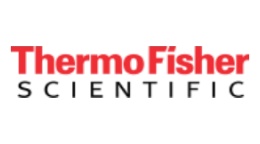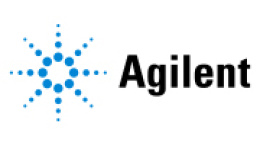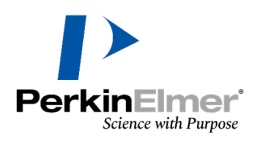方案详情文
智能文字提取功能测试中
Ion Chromatography ICP-Q-MSfor the Detection of ArsenicSpecies in Apple Juice Daniel Kutscher, Shona McSheeby-Ducos', Julian Wills, and Detlef Jensen;1Thermo Fisher Scientific, Bremen, Germany; 2Thermo Fisher Scientific, Olten, Switzerland Overview Purpose: This paper describes and assesses the coupling of the ThermoScientific Dionex ICS-5000 RFIC system to the Thermo Scientific XSERIES 2ICP-Q-MS for the determination of inorganic and organic arsenic species inapple juice. Methods: Anion-exchange chromatography coupled to the XSERIES 2TM ICP-Q-MS was used. The Thermo Scientific Dionex lonPac AS-7 column used in thisstudy can separate both cationic and anionic species.1 Results: A robust IC-ICP-MS system comprising a Dionex ICS-5000 systemand an XSERIES 2 ICP-Q-MS was developed and shown to be a highlyselective and sensitive technique for determination of trace element species. Introduction Interest in the determination of arsenic species in fruit juices has been triggeredby recent media reports in the United States claiming that some apple juicesmay contain high amounts of arsenic (As).2 Total arsenic was assessed in thesereports however there was no investigation of the chemical form of the arsenicfound. This is an important distinction because the inorganic forms of Arsenic(As3+ and As5+) are highly toxic, whereas the organic forms (e.g., arsenobetaine)are not considered toxic. Typical levels of total As found in apple juice are lowerthan the US EPA drinking maximum contaminant level (MCL) of 10 ng/g soapple juice is generally considered safe and is currently not regulated.3 Methods Sample Preparation Four different apple juices were purchased in a local supermarket. Aliquots ofeach sample were acidified and diluted, and the arsenic content determinedusing method of standard additions on the XSERIES 2 ICP-MS. One sample, inwhich no arsenic was found, was spiked with various amounts of arsenicspecies and analyzed to determine the spike recovery. The amount spiked wasin the range of 10 to 20 ng/g, which meets or slightly exceeds the regulation setby US FDA for bottled water (10 ng/g). There is currently no regulation forarsenic levels in fruit juices. Samples which showed the presence of arsenicwere then measured for arsenic species by IC-ICP-MS. Liquid Chromatography Chromatographic separations were carried out using the Dionex ICS-5000 ionchromatography system. Thermo Scientific Dionex anion-exchange columnssupplied were used. Conditions can be found in Table 1. TABLE 1. Conditions for chromatographic separations of As species Parameter Value Column Dionex lonPacTM AS7 (2 mm i.d. 250 mm length) Elution Gradient elution (0.3 mL/min) Mobile phase A: 20 mmol/L Ammonium carbonate, pH 9 B: 200 mmol/L Ammonium carbonate, pH 9 Gradient from 20 to 200 mmol/L in 15 min Injection volume 20 pL Duration 15 min + column conditioning ICP Mass Spectrometry The XSERIES 2 ICP-Q-MS was used throughout this study. The operatingparameters are summarized in Table 2. For the detection of arsenic, the collisioncell was pressurized with helium to remove the spectral interference from40Ar35Cl at m/z 75. TABLE 2. Conditions for XSERIES 2 ICP-MS Parameter Value Forward power 1550 W Nebulizer gas 0.80 L/min Injector 2 mm i.d. Cones Xt Cell gas flow /KED voltage 4.8 mL/min He/2V Dwell time 100 ms Figure 1. IC-ICP-MS system: Dionex ICS-5000 system coupled to XSERIES 2ICP-Q-MS system ResultsSpeciation of As in Apple Juice A synthetic mixture containing 10 ng/g of six As species (inorganic As3+ and As5+,organic arsenobetaine [AsB], arsenocholine [AsC], monomethylarsonic acid[MMA], and dimethylarsinic acid [DMA]) was analyzed using the IC-ICP-MSsystem described above. Figure 2 shows the resulting chromatogram. FIGURE 2. Chromatographic separation of six As species in dilute HNO3 TABLE 3. Retention times and peak widths observed for the six As species measured Compound Retention Time(s) Peak Width(s) AsB 185 15 DMA 205 10 As3+ 215 15 AsC 270 15 MMA 400 30 As5+ 800 20 The Thermo Scientific PlasmaLab software for the XSERIES 2 system featuresa complete chromatographic integration tool set which was utilized to integratethe individual peaks and determine the concentrations of each of the arsenicspecies. External calibration curves were prepared over a concentration range of1 to 20 ng/g. The calibration curves for each of the six different arsenic speciesare shown in Figure 3, indicating excellent linearity and sensitivity. FIGURE 3. Fully quantitative calibration graphs for AsB (a), DMA (b), As3+(c), AsC (d), MMA (e), and As5+(f). Although DMA and As3+ elute at similar retention times (with a difference about10 s, which leads to slight co-elution between both species), evaluation of thepeak area was still possible with good accuracy using the chromatographicintegration features of PlasmaLab software. Detection limits were calculated based on three times the standard deviation offour repeat blank injections for each arsenic species. The detection limits areshown in Table 4 below. TABLE 4. Detection limits for Arsenic species by IC-ICP-MS Compound Detection Limit (pg/g) AsB 2.3 DMA 3.8 As3+ 4.6 AsC 4.4 MMA 11.4 As5+ 1.2 Determination of Spike Recovery Since initial analyses of locally sourced apple juices indicated no presence of As,a juice sample was spiked with varying amounts of the six As species underinvestigation and analyzed in order to determine the spike recovery. TABLE 5. Spike recovery obtained for six As species spiked into apple juice Species Expected (ng/g) Found (ng/g) Recovery (%) AsB 2.19 2.27 104 DMA 1.40 1.15 82 As3+ 1.35 1.38 102 AsC 1.94 1.87 94 MMA 1.09 1.13 104 As5+ 1.10 1.07 98 As can be seen from the results in Table 5, spike recovery was quantitative forall species except for DMA, which had a spike recovery in the range of 82%,possibly due to decomposition of the compound. Speciation of Arsenic in Apple Juice Samples Two juices in a subsequent batch were found to contain trace (~1.8 ng/g) levelsof arsenic. These samples were then subjected to speciation analysis todetermine whether the arsenic found was present in its nontoxic organic forms,or in its toxic inorganic species. The limit of detection (LOD) for the total Asconcentration was calculated to be 5 pg/g in the undiluted apple juice. FIGURE 4. Chromatogram of an apple juice sample showing peaks for As3+andAs5+, MMA, and DMA One of the resulting chromatographs is shown in Figure 4. The arsenic wasidentified as both the inorganic (toxic) species As3+ and As5+ and as the MMAand DMA organic forms. In the second juice sample, the arsenic was found onlyin the toxic inorganic forms. The results of the species specific quantification are shown in Table 6 togetherwith the total arsenic concentration determined previously. Each juice samplewas analyzed in triplicate. TABLE 6. Fully quantitative concentration of different As species and totalAs determined in apple juice samples Juice DMA (ng/g) As3+(ng/g) MMA(ng/g) As5+(ng/g) Total As(ng/g) Juice 3 一 0.5±0.01 一 0.7±0.01 1.7±0.05 Juice 4 0.4±0.05 0.3±0.01 0.1±0.05 0.7±0.01 1.8±0.05 The results for the arsenic speciation analysis and total arsenic analysis are inagreement. Other arsenic species being present in concentrations below theLOD might be responsible for the slight difference between the total Asconcentration and the sum of all species. The trace amounts of As found alsocorrespond to the range of arsenic concentrations typically found in apple juicesas published by the US FDA (between 2 and 6ng/g).3 Conclusion ·The combination of the Dionex ICS-5000 ion chromatography system with theXSERIES 2 ICP-Q-MS provides a highly sensitive, routine IC-ICP-MS techniquefor the determination of trace metal species. ·A highly sensitive and specific method for the speciation analysis of arsenic inapple juice samples has been developed and applied to the analysis of differentjuices after a simple tenfold dilution. ·The Dionex lonPac AS7 anion-exchange column used in this study was not onlyable to efficiently separate six different arsenics species, but also helped toimprove the sensitivity of the technique by concentrating each eluted species intoa narrow peak. The low flow rate of 0.3 mL/min helps to reduce both sample andmobile phase consumption. References 1. Dionex homepage http://www.dionex.com/en-us/products/columns/ic-rfic/specialty-packed/ionpac-as7/lp-73274.html 2. Letters from the FDA to the Dr. Oz Show Regarding Apple Juice and Arsenichttp://www.fda.gov/Food/ResourcesForYou/Consumers/ucm271746.htm 3. Questions and Answers: Apple Juice and Arsenic: http://news.consumerreports.org/Consumer%20Reports%20Arsenic%20Test%20Results%20January%202012.pdf www.thermoscientific.com/dionex Thermo Scientific Dionex products aredesigned, developed, and manufacturedunder an ISO 9001 Quality System. U.S./Canada (847) 295 7500 Denmark (45) 36 36 90 90 Sweden (46) 8 473 3380 India (91) 22 2764 2735 Brazil (55) 11 3731 5140 France (33)1393001 10 Switzerland (41)622059966 Japan (81)66885 1213 Austria (43)161651 25 Germany (49)61269910 United Kingdom (44) 1276 691722 Korea (82) 22653 2580 Benelux (31) 20 683 9768 Ireland (353)1644 0064 Australia (61)29420 5233 Singapore (65) 6289 1190 (32) 3 353 42 94 Italy (39)0251 62 1267 China (852) 2428 3282 Taiwan (886)2 8751 6655 lon Chromatography ICP-Q-MS for the Detection of Arsenic Species in Apple Juice
关闭-
1/7
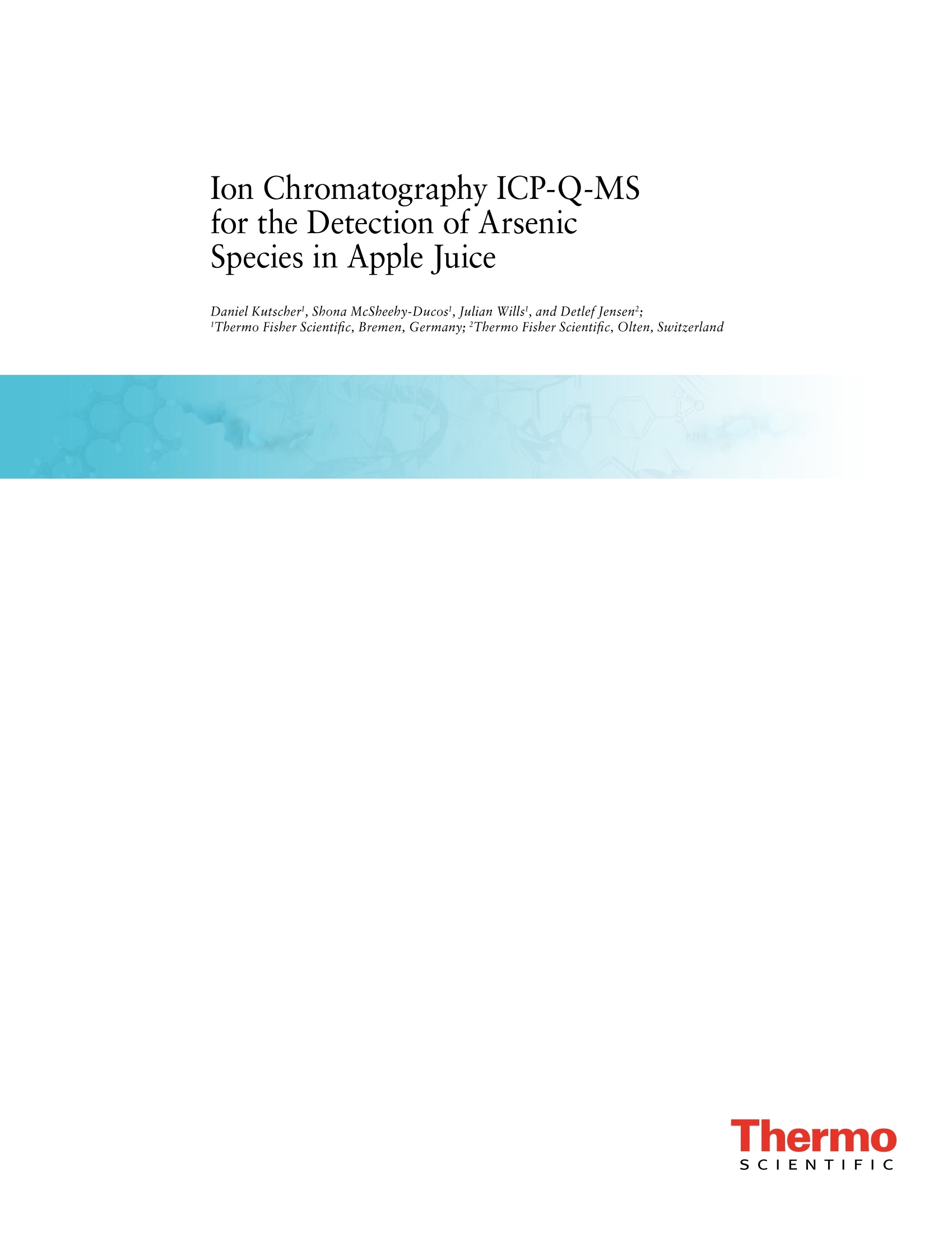
-
2/7
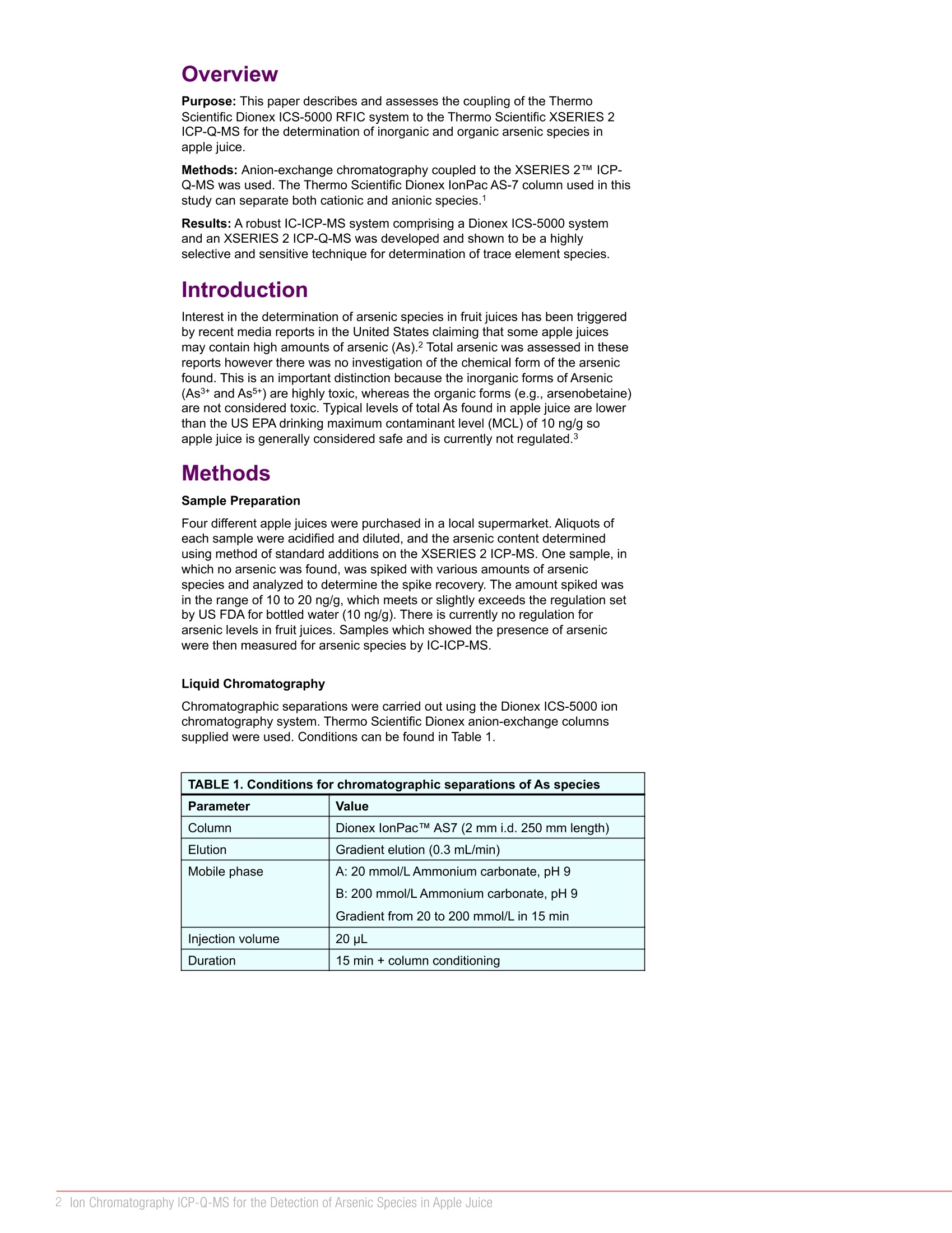
还剩5页未读,是否继续阅读?
继续免费阅读全文产品配置单
赛默飞色谱与质谱为您提供《苹果汁中微量元素测定检测方案 》,该方案主要用于果蔬汁类及其饮料中营养成分检测,参考标准《暂无》,《苹果汁中微量元素测定检测方案 》用到的仪器有赛默飞戴安ICS-5000+高压离子色谱系统。
我要纠错
相关方案
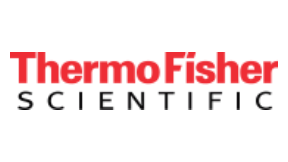

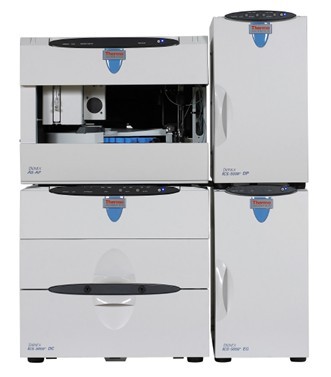
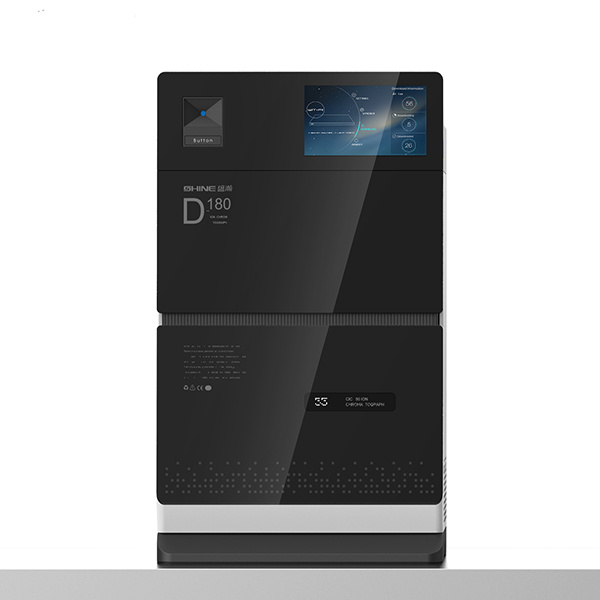
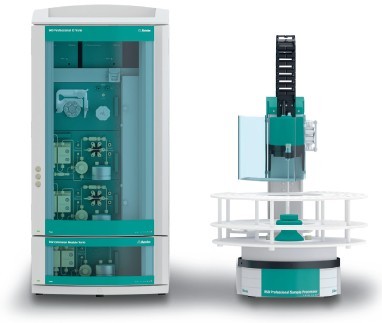
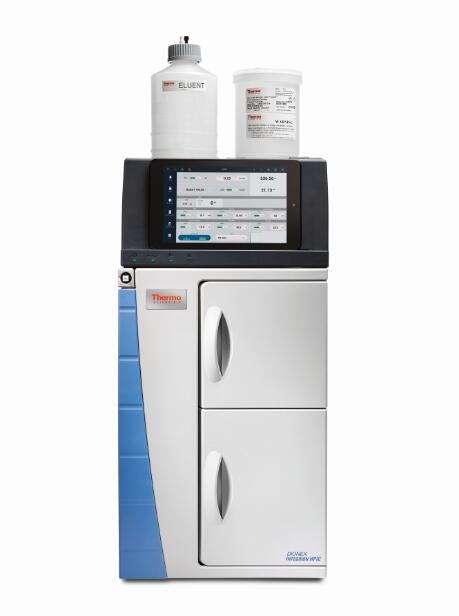
 咨询
咨询